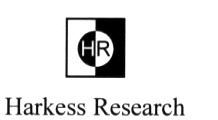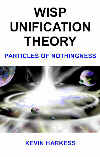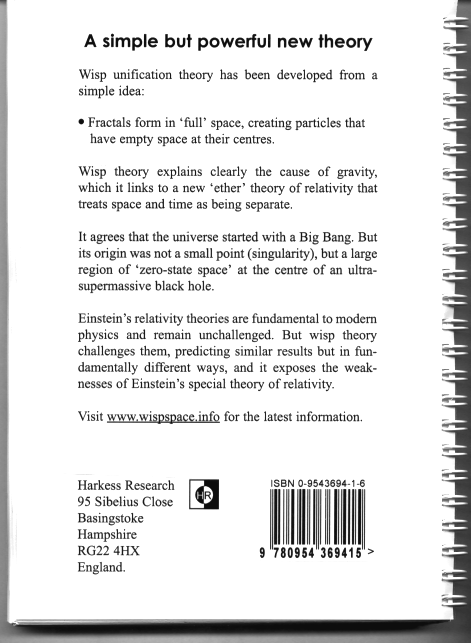
 Wisp
Unification Theory - Contents
Wisp
Unification Theory - Contents
- Home
- About Me
- Reasons why Einstein was wrong
- One-way speed of light experiments
- Hot topic
- Q&A
- ACES - The end of Relativity

- Book Contents
- Introduction
- 1 Matter,Space and Time
- 2 Symmetry
- 3 Fractals
- 4 Wisp Space
- 5 Gravity
- 6 Electromagnetic Force
- 7 Wisp & S.R: Fundamentals
- 8 Wisp & S.R: Electrodynamics
- 9 Wisp & S.R: Doppler effect
- 10 Wisp & S.R: Relativistic Mechanics
- 11 Big bang
- Appendix A
- Appendix B
- Index A-Z
- Copyright
- Feedback
This page contains the complete contents. To download the new 2011 2nd edition of wisp unification theory go to the homepage.
Contents
Introduction xiii
1 Matter, Space and Time1 1.1 Basic understanding 1
1.1.1 – Matter 1
1.1.2 – Space 1
1.1.3 – Time 1
1.1.4 – Perception of reality 2
1.2 Advanced understanding 3
1.2.1 – Matter 3
1.2.1.1 – Quantum theories 3
1.2.1.2 – Fields 3
1.2.1.3 – Mass 4
1.2.1.4 – Mass energy equivalence 4
1.2.1.5 – The standard model 4
1.2.1.6 – Supersymmetry theory 6
1.2.1.7 – String theories 6
1.2.1.8 – M-Theory 7
1.2.2 – Space and time 7
1.2.2.1 – Einstein’s space–time 7
1.2.2.2 – String theory’s space–time 7
1.2.2.3 – Time dilation 8
1.2.2.4 – Unit of time 8
1.2.2.5 – Demise of the ether 8
1.3 Incompatible theories 8
1.4 Theory foundations – roots 9
1.4.1 – Wisp theory roots/history 11
2 Symmetry 13
2.1 Symmetry 13
2.2 Face-centred cubic lattice 14
2.3 Spherical sphere packing 14
2.4 Symmetry-breaking 16
2.5 Antimatter 18
2.6 Subatomic particles 18
3 Fractals 21
3.1 Fractal patterns 21
3.1.1 – Cantor dust 21
3.1.2 – Binary tree 24
3.2 Particle fractals – ‘matter-fractals’ 24
4 Wisp Space 25
4.1 Wisp space’s structure 25
4.1.1 – States of space 25
4.1.2 – Wisps 26
4.1.3 – Matter-fractals 26
4.2 Early ether theories 29
4.2.1 – René Descartes 29
4.2.2 – James Clerk Maxwell 29
4.2.3 – J.J. Thomson 30
4.2.4 – Michelson and Morley 30
4.2.5 – Insufficient proof 30
4.3 Waves in wisp space 31
4.3.1 – Transverse waves 32
4.3.2 – Longitudinal waves 32
4.3.3 – EPR Paradox 33
4.4 Matter-fractal’s motion through wisp space 34
4.5 Absolute frames of reference 35
4.5.1 – Local absolute frames of reference 35
4.6 Newton’s laws of motion 36
4.6.1 – Newton’s first law of motion 36
4.6.2 – Newton’s second law of motion 36
4.6.3 – Newton’s third law of motion 37
5 Gravity 39
5.1 The weakest force 39
5.2 Current theories 40
5.2.1 – Newton’s law of gravitation 40
5.2.2 – Einstein’s general theory of relativity 41
5.2.3 – Other theories 42
5.3 Wisp theory of gravitation 43
5.3.1 – Curved wisp space 44
5.3.2 – Tension and compression forces 45
5.3.3 – Force and the inverse-square law 47
5.3.4 – Why obey the inverse-square law? 49
5.3.5 – Newton’s thoughts 50
5.3.6 – Wisp gravitational force 52
5.3.7 – Zero-state space shock waves 53
5.3.8 – Calculating gravitational acceleration 55
5.3.9 – Bending Light 59
5.4 Podkletnov’s experiments 60
5.4.1 – Gravity shielding 60
5.4.2 – Impulse gravity generator 62
5.5 Quantum gravitational effects 64
5.6 Pioneers’ orbital discrepancies 64
5.7 Gravity Probe B 66
5.8 Conclusion 66
6 Electromagnetic Force 69
6.1 Electric force 69
6.2 Magnetic force 70
6.3 Light 72
6.3.1 – Zero rest mass 74
7 Wisp and Special Relativity: Fundamentals 75
7.1 Postulates and implications of special relativity 76
7.1.1 – Postulate 1: principle of relativity 76
7.1.2 – Postulate 2: absoluteness of the speed of light 76
7.1.3 – Implications of postulate 1 76
7.1.4 – Implications of postulate 2 78
7.2 The postulates of wisp relativity 79
7.2.1 – Postulate 1 Laws are different 79
7.2.2 – Postulate 2 Absolute speeds are constant 79
7.2.3 – Postulate 3 Gamma factor 79
7.2.4 – Postulate 4 Jiggle 80
7.2.5 – Postulate 5 Force reduction and time dilation 80
7.3 Measurements: absolute and relative 80
7.3.1 – Absolute measurements 80
7.3.2 – Relative measurements 81
7.4 Events 82
7.5 Absolute measurements of light’s relative speed 82
7.5.1 – Absolute measurements in a stationary frame 84
7.5.2 – Absolute measurements in a moving frame 84
7.6 Gamma factors 89
7.6.1 – Time dilation: light-pulse clocks 89
7.6.2 – Force reduction 91
7.6.3 – Jiggle 92
7.6.4 – Time dilation: mechanical/biological clocks 94
7.7 The Michelson-Morley experiment 96
7.7.1 – One-way light speed test 99
7.8 Kennedy-Thorndike experiment 100
7.9 Stellar aberration 100
7.10 Fizeau’s experiment 101
7.11 Wisp coordinate and frame velocity transformations 102
7.11.1 – Wisp frame velocity transformation 103
7.12 Invariance of distance 105
7.13 Absolute simultaneity: events 105
7.14 Mass invariance 108
7.14.1 – Relativistic mass increase: quasi-mass 108
7.14.2 – Accelerating subatomic particles 109
7.14.3 – Decelerating subatomic particles 111
7.15 Wisp accelerations and transformations 111
7.15.1 – Particle accelerator force magnitudes 112
7.15.2 – Wisp acceleration transformations 113
7.15.3 – Motion produced by a force-device in absolute frame S 115
7.15.3.1 – Motion produced by a force-device moving in frame S 117
7.15.4 – Rules for time dilation compensation 119
7.15.4.1 – Motion produced by a moving force-device with respect
to frame S’ 121
7.16 Absolute speed of light 124
7.17 Earth’s absolute and relative times 125
8 Wisp and Special Relativity: Electrodynamics 127
8.1 Electrodynamics of moving bodies 129
8.2 Force measurements in different frames 129
8.2.1 – Electromagnetic force in absolute frame S 129
8.2.2 – Electromagnetic force in moving frame S’ 130
8.2.3 – Electric force on wire moving through wisp space 133
8.3 Ether re-established 135
9 Wisp and Special Relativity: Doppler Effect 137
9.1 The Doppler effect of light 137
9.1.1 – Light source device 139
9.2 Doppler effect: 139
9.2.1 – transverse observer motion 139
9.2.2 – transverse source motion 141
9.2.3 – transverse Doppler effect experiments 141
9.2.4 – testing a moving observer’s transverse Doppler effect
143
9.2.5 – observer receding from a stationary source 143
9.2.6 – observer approaching a stationary source 146
9.2.7 – source moving and observer stationary 146
9.3 Doppler effect – general motion: observer and source moving 147
10 Wisp and Special Relativity: Relativistic Mechanics 151
10.1 Conservation of momentum 151
10.2 E = mc^2 155
10.2.1 – Energy into mass 158
10.3 Conservation of charge 159
11 Big Bang 161
11.1 Black holes 161
11.1.1 – General relativity 161
11.1.2 – Points of singularity 163
11.1.3 – Supermassive black holes 163
11.1.4 – Ultra-supermassive black hole 163
11.2 COBE (launched 1989) 164
11.3 Wisp big bang theory 164
11.3.1 – Inflation 165
11.3.2 – Redshift 165
11.3.3 – Galaxy formation 166
11.3.4 – Star speeds in rotating galaxies 166
11.3.5 – The big crunch 167
Appendices
A Wisp versus Special Relativity Test 169
A.1 – Transverse Doppler effect experiment 169
A.2 – Initial data 170
A.3 – Special relativity’s formula 170
A.4 – Wisp theory’s formula 173
A.5 – Comparison 173
A.6 – Analysing data 174
B Fizeau’s Experiment 177
B.1 – Apparatus 177
B.2 – Theory 180
B.3 – Applying wisp theory to SR’s formula 181
B.4 – Applying wisp theory to Fresnel’s formula 184
B.5 – Conclusion 184
A-Z Index 185
Rear Cover

Home --
About Me -- Reasons
why Einstein was wrong -- One-way
speed of light experiments -- Hot
topic -- Q&A -- ACES
- The end of Relativity --
Book Contents -- Introduction
-- 1 Matter,
Space and Time -- 2
Symmetry -- 3
Fractals -- 4 Wisp Space
-- 5 Gravity -- 6
Electromagnetic Force --
7 Wisp & S.R: Fundamentals
-- 8 Wisp & S.R: Electrodynamics
-- 9 Wisp
& S.R: Doppler effect -- 10
Wisp & S.R: Relativistic Mechanics --
11 Big bang -- Appendix
A -- Appendix B -- Index
A-Z -- Copyright -- Feedback